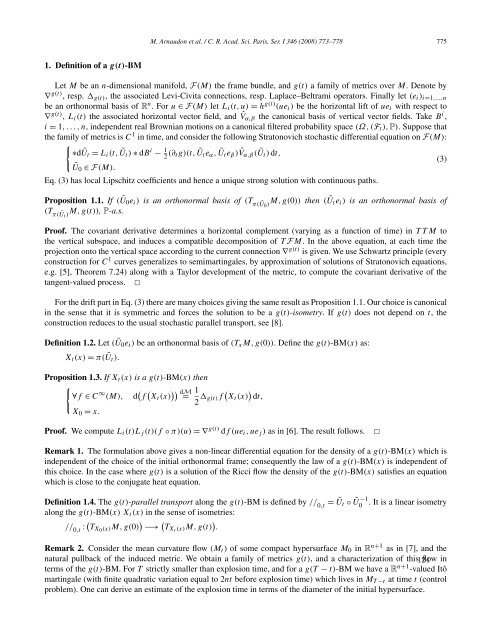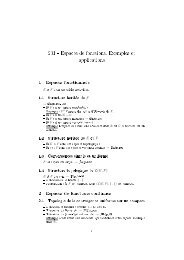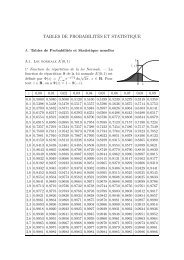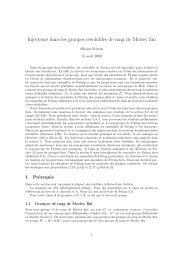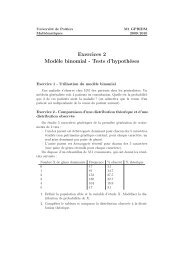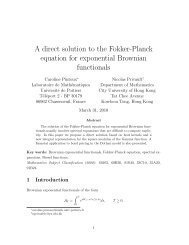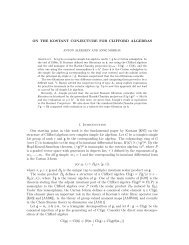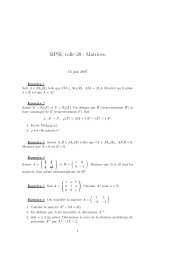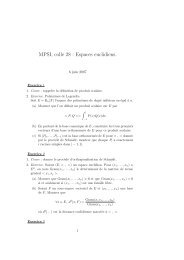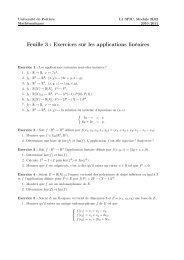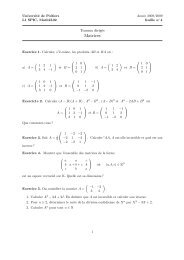M. Arnaudon et al. / C. R. Acad. Sci. Paris, Ser. I 346 (2008) 773–778 7751. Definition of a g(t)-BMLet M be an n-dimensional manifold, F(M) the frame bundle, and g(t) a family of metrics over M. Denote by∇ g(t) , resp. g(t) , the associated Levi-Civita connections, resp. Laplace–Beltrami operators. Finally let (e i ) i=1,...,nbe an orthonormal basis of R n .Foru ∈ F(M) let L i (t, u) = h g(t) (ue i ) be the horizontal lift of ue i with respect to∇ g(t) , L i (t) the associated horizontal vector field, and ˆV α,β the canonical basis of vertical vector fields. Take B i ,i = 1,...,n, independent real Brownian motions on a canonical filtered probability space (Ω, (F t ), P). Suppose thatthe family of metrics is C 1 in time, and consider the following Stratonovich stochastic differential equation on F(M):{∗dŨ t = L i (t, Ũ t ) ∗ dB i − 1 2 (∂ tg)(t, Ũ t e α , Ũ t e β ) ˆV α,β (Ũ t ) dt,(3)Ũ 0 ∈ F(M).Eq. (3) has local Lipschitz coefficients and hence a unique strong solution with continuous paths.Proposition 1.1. If (Ũ 0 e i ) is an orthonormal basis of (T π(Ũ0 ) M,g(0)) then (Ũ t e i ) is an orthonormal basis of(T π(Ũt )M,g(t)), P-a.s.Proof. The covariant derivative determines a horizontal complement (varying as a function of time) in TTM tothe vertical subspace, and induces a compatible decomposition of T FM. In the above equation, at each time theprojection onto the vertical space according to the current connection ∇ g(t) is given. We use Schwartz principle (everyconstruction for C 1 curves generalizes to semimartingales, by approximation of solutions of Stratonovich equations,e.g. [5], Theorem 7.24) along with a Taylor development of the metric, to compute the covariant derivative of thetangent-valued process. ✷For the drift part in Eq. (3) there are many choices giving the same result as Proposition 1.1. Our choice is canonicalin the sense that it is symmetric and forces the solution to be a g(t)-isometry. Ifg(t) does not depend on t, theconstruction reduces to the usual stochastic parallel transport, see [8].Definition 1.2. Let (Ũ 0 e i ) be an orthonormal basis of (T x M,g(0)). Define the g(t)-BM(x) as:X t (x) = π(Ũ t ).Proposition 1.3. If X t (x) is a g(t)-BM(x) then{∀f ∈ C ∞ (M), d ( f ( X t (x) )) dM =12 g(t)f ( X t (x) ) dt,X 0 = x.Proof. We compute L i (t)L j (t)(f ◦ π)(u) =∇ g(t) df(ue i ,ue j ) as in [6]. The result follows.✷Remark 1. The formulation above gives a non-linear differential equation for the density of a g(t)-BM(x) which isindependent of the choice of the initial orthonormal frame; consequently the law of a g(t)-BM(x) is independent ofthis choice. In the case where g(t) is a solution of the Ricci flow the density of the g(t)-BM(x) satisfies an equationwhich is close to the conjugate heat equation.Definition 1.4. The g(t)-parallel transport along the g(t)-BM is defined by // 0,t= Ũ t ◦ Ũ −10. It is a linear isometryalong the g(t)-BM(x) X t (x) in the sense of isometries:// 0,t : ( T X0 (x)M,g(0) ) −→ ( T Xt (x)M,g(t) ) .Remark 2. Consider the mean curvature flow (M t ) of some compact hypersurface M 0 in R n+1 as in [7], and thenatural pullback of the induced metric. We obtain a family of metrics g(t), and a characterization of this124flow intermsoftheg(t)-BM. For T strictly smaller than explosion time, and for a g(T − t)-BM we have a R n+1 -valued Itômartingale (with finite quadratic variation equal to 2nt before explosion time) which lives in M T −t at time t (controlproblem). One can derive an estimate of the explosion time in terms of the diameter of the initial hypersurface.
776 M. Arnaudon et al. / C. R. Acad. Sci. Paris, Ser. I 346 (2008) 773–7782. Damped parallel transportConsider{∂ t f(t,x)= 1 2 g(t)f(t,x),(4)f(0,x)= f 0 (x)where f 0 is a smooth function on M and where g(t) is the Laplacian on M with respect to g(t). LetXt T (x) be ag(T − t)-BM(x) and define the g(T − t)-parallel transport // T 0,tas before.Definition 2.1. The damped parallel transport W0,t T : T xM −→ T X T t (x)M is defined as the solution ofd (( // T 0,t) −1W )T 1( )0,t =− //T −1 (2 0,t Ricg(T −t) ( )) #g(T −t) ( )−∂ t g(T − t) WT0,t dt, WT0,0 = id .Theorem 2.2. For any f 0 ∈ F(M), and f(t,·) asolutionof (4), the processdf(T − t,·) X T t (x) W 0,t T v, 0 t T,is a local martingale for any v ∈ T x M.Heredf denotes the de Rham differential of f .Proof. We use scalarization of a differential form to bring computations back in R n . The proof then relies on commutativityof de Rham differential and Hodge de Rham Laplacian, along with the Weitzenböck formula for differentialforms. ✷Takingdt d g ij (t) =−Ric ij (t) as definition of the forward Ricci flow, the associated heat equation is:⎧∂ t f(t,x)= 1 ⎪⎨2 g(t)f(t,x),d⎪⎩ dt g ij =−Ric ij ,f(0,x)= f 0 (x)where f 0 is a smooth function on M.(5)Remark 3. The Ricci flow of a compact manifold develops its first singularity in finite time which we denote by T c .For T
- Page 1:
Université de PoitiersTHÈSEpour o
- Page 4 and 5:
AbstractIn the first part of this t
- Page 6 and 7:
ivTABLE DES MATIÈRES3 Kendall-Cran
- Page 8 and 9:
8 CHAPITRE 1. INTRODUCTIONdifféren
- Page 10 and 11:
10 CHAPITRE 1. INTRODUCTIONdonne se
- Page 12 and 13:
12 CHAPITRE 1. INTRODUCTIONHamilton
- Page 14 and 15:
14 CHAPITRE 1. INTRODUCTIONx et ell
- Page 16 and 17:
16 CHAPITRE 1. INTRODUCTIONCette é
- Page 18 and 19:
18 CHAPITRE 1. INTRODUCTION- Exempl
- Page 20 and 21:
20 CHAPITRE 1. INTRODUCTION20
- Page 22 and 23:
22CHAPITRE 2. INTRODUCTION À L’A
- Page 24 and 25:
24CHAPITRE 2. INTRODUCTION À L’A
- Page 26:
26CHAPITRE 2. INTRODUCTION À L’A
- Page 29 and 30:
2. ÉQUATIONS DIFFÉRENTIELLES STOC
- Page 31 and 32:
2. ÉQUATIONS DIFFÉRENTIELLES STOC
- Page 33 and 34:
3. QUELQUES APPLICATIONS DU CALCUL
- Page 35 and 36:
Chapitre 3Brownian motion with resp
- Page 37 and 38:
for every smooth function f,is a lo
- Page 39 and 40:
For the solution U t of (1.1) we ge
- Page 41 and 42:
Remark : Recall that in the compact
- Page 43 and 44:
2 Local expression, evolution equat
- Page 45 and 46:
The last equality comes from Green
- Page 47 and 48:
Theorem 3.2 For every solution f(t,
- Page 49 and 50:
Consequently:d(df(T − t, .) X Tt
- Page 51 and 52:
Proof : The first remark after theo
- Page 53 and 54:
Remark : Hamilton gives a proof of
- Page 55 and 56:
Corollary 3.7 For χ(M) < 0, there
- Page 57 and 58:
We also have:D S,T −t dπ ˜// 0,
- Page 59 and 60:
Proof : By differentiation under x
- Page 61 and 62:
where we have used in the second eq
- Page 63 and 64:
[10] K. D. Elworthy and M. Yor. Con
- Page 65 and 66:
Chapter 4Some stochastic process wi
- Page 67 and 68:
We will just look at the smooth sol
- Page 69 and 70:
that is to say:d(Y T,it ) = − ∂
- Page 71 and 72:
2 Tightness, and first example on t
- Page 73 and 74: proof : It is clear that F is smoot
- Page 75 and 76: Proposition 2.6 Let g(t) be a famil
- Page 77 and 78: v) ˜g(∞) is a metric such that (
- Page 79 and 80: Then:for all ɛ > 0 , there exists
- Page 81 and 82: Finally, we obtain:∂∂t | t=t 0
- Page 83 and 84: where Ut 3 is the horizontal lift o
- Page 85 and 86: √πWe can choose ɛ, ɛ 2 such th
- Page 87 and 88: We will now show that the coupling
- Page 89 and 90: HenceWe get:√√ n∑1 − ɛI t
- Page 91 and 92: By uniqueness in law of such proces
- Page 95 and 96: Chapter 5Horizontal diffusion in pa
- Page 97 and 98: 2 M. ARNAUDON, A. K. COULIBALY, AND
- Page 99 and 100: 4 M. ARNAUDON, A. K. COULIBALY, AND
- Page 101 and 102: 6 M. ARNAUDON, A. K. COULIBALY, AND
- Page 103 and 104: 8 M. ARNAUDON, A. K. COULIBALY, AND
- Page 105 and 106: 10 M. ARNAUDON, A. K. COULIBALY, AN
- Page 107 and 108: 12 M. ARNAUDON, A. K. COULIBALY, AN
- Page 109 and 110: 14 M. ARNAUDON, A. K. COULIBALY, AN
- Page 111 and 112: 16 M. ARNAUDON, A. K. COULIBALY, AN
- Page 113 and 114: Chapter 6Compléments de calculs113
- Page 115 and 116: d’avoir une famille de connexion,
- Page 117 and 118: Dans le calcul de ligne 8 à ligne
- Page 119 and 120: On utilise le fait que W (.) t est
- Page 121 and 122: Chapter 7Appendix121121
- Page 123: 774 M. Arnaudon et al. / C. R. Acad
- Page 127 and 128: 778 M. Arnaudon et al. / C. R. Acad
- Page 129 and 130: Bibliography[ABT02]Marc Arnaudon, R
- Page 131 and 132: BIBLIOGRAPHY 131[DeT83][Dri92]Denni
- Page 133 and 134: BIBLIOGRAPHY 133[Jos84][Jos05][JS03
- Page 135 and 136: 135


